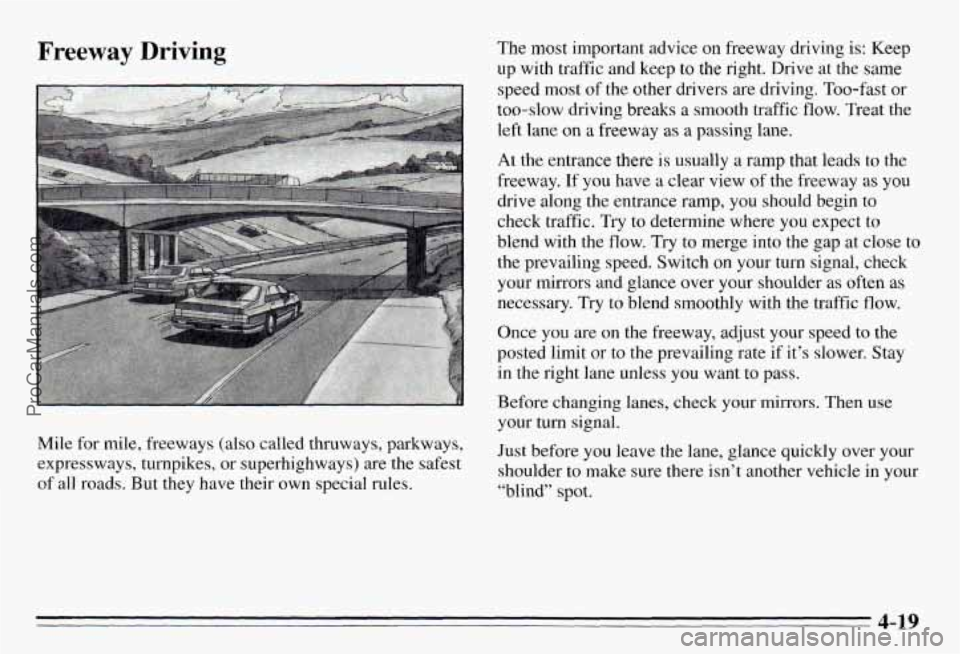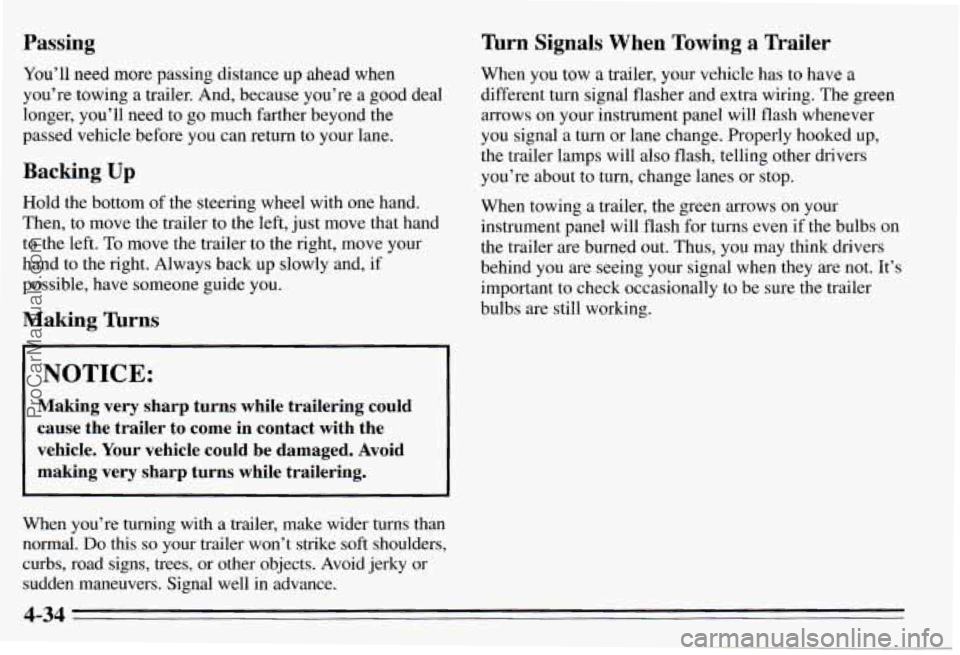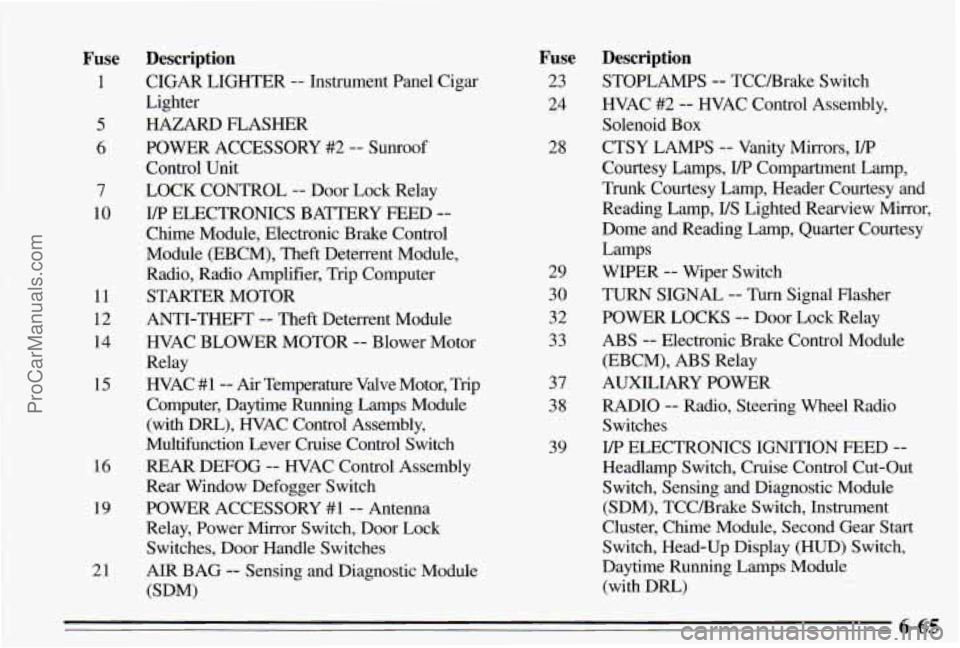Page 161 of 354
City Driving
One of the biggest problems with city streets is the
amount of traffic on them. You’ll want to watch out for
what the other drivers are doing and pay attention
to
traffic signals.
Here are ways to increase your safety in city driving:
Try to use the freeways that rim and crisscross most
large cities. You’ll save time and energy. (See
the
next part, “Freeway Driving.”)
0 Treat a green light as a warning signal. A traffic light
is there because the corner is busy enough to need it.
When a light
turns green, and just before you start to
move, check both ways for vehicles that have not
cleared the intersection or may be running the red
light.
4-18
ProCarManuals.com
Page 162 of 354

Freeway Driving
Mile for mile, freeways (also called thruways, parkways,
expressways, turnpikes, or superhighways) are the safest
of all roads. But they have their own special rules. The
most important advice on freeway driving is: Keep
up with traffic and keep to the right. Drive at the same
speed most
of the other drivers are driving. Too-fast or
too-slow driving breaks
a smooth traffic flow. Treat the
left
lane on a freeway as a passing lane.
At the entrance there is usually a ramp that leads to the
freeway.
If you have a clear view of the freeway as you
drive along the entrance ramp, you should begin to
check traffic.
Try to determine where you expect to
blend with the flow. Try to merge into the gap at close to
the prevailing speed. Switch
on your turn signal, check
your mirrors and glance over your shoulder as often as
necessary. Try to blend smoothly with the traffic flow.
Once you are on the freeway, adjust your speed to the
posted
limit or to the prevailing rate if it’s slower. Stay
in the right lane unless you want to pass.
Before changing lanes, check your mirrors. Then use
your turn signal.
Just before you leave the lane, glance quickly over your
shoulder to make sure there isn’t another vehicle in your
“blind” spot.
4-19
ProCarManuals.com
Page 177 of 354

Passing
You’ll need more passing distance up ahead when
you’re towing a trailer. And, because you’re
a good deal
longer, you’ll need to go much farther beyond the
passed vehicle before you can
return to your lane.
Backing Up
Hold the bottom of the steering wheel with one hand.
Then, to move the trailer
to the left, just move that hand
to the left.
To move the trailer to the right, move your
hand to the right. Always back
up slowly and, if
possible, have someone guide you.
Making Th-ns
I NOTICE:
Making very sharp turns while trailering could
cause the trailer to come in contact with the
vehicle. Your vehicle could be damaged. Avoid
making very sharp turns while trailering.
When you’re turning with a trailer, make wider turns than
normal.
Do this so your trailer won’t strike soft shoulders,
curbs, road signs, trees, or other objects. Avoid jerky or sudden maneuvers. Signal well in advance.
mrn Signals When Towing a Trailer
When you tow a trailer, your vehicle has to have a
different turn signal flasher and extra wiring. The green
arrows on your instrument panel will flash whenever
you signal a turn or lane change. Properly hooked up,
the trailer lamps will also flash, telling other drivers
you’re about to turn, change lanes or stop.
When towing a trailer, the green arrows on your
instrument panel will flash for turns even if the bulbs on
the trailer are burned out. Thus, you may thmk drivers
behind you are seeing your signal when they
are not. It’s
important to check occasionally to be sure the trailer
bulbs are still working.
4-34
ProCarManuals.com
Page 180 of 354
Section 5 Problems on the Road
Here you'll find what to do about some problems that
can occur on the road.
Hazard Warning Flashers
Your hazard warning flashers let you warn others. They
also let police know you have
a problem. Your front and
rear turn signal lamps will flash
on and off.
Press the switch to
make
your front and rear turn
signal lamps flash on and
off. Your hazard warning
flashers work
no matter
what position your key is
in,
To turn off the flashers, press the switch again. When
the hazard warning flashers are on, your
turn signals
won't work.
5-1
ProCarManuals.com
Page 251 of 354
Front Sidemarker (&Door Models) Front Turn Signal (2-Door Models)
1.
2.
Remove the screws and
pull the sidemarker
housing forward.
Turn the socket
counterclockwise and
pull the socket out
of the
housing.
3.
4.
5.
6.
7.
Pull the bulb out of the socket.
fish
in a new bulb.
Replace the socket into the housing
and turn
clockwise.
Replace the housing to the vehicle.
Install the screws-
45 -3
L A
1. Remove the pins from the cover above the turn
signal lamps.
6-38 ProCarManuals.com
Page 252 of 354
3.
4.
5.
6.
7.
Turn the socket
counterclockwise 1/6-tum until it feels
loose.
Pull out~the socket.
Pull the bulb out
of the socket.
Push
in a new bulb.
Replace the socket into the housing and
turn
clockwise until it snaps in place.
Replace the cover and pins.
Front Turn Signal (4-Door Models)
)I 1. Remove the screws and
3. Pull out the bulb socket.
2.
pull the turn signal
housing forward.
Turn the bulb socket counterclockwise until
it pops loose from the
housing.
4. Lift the plastic locking tab on the electrical
connector and pull the connector from the bulb
socket.
5. Snap the electrical connector into a new bulb socket.
6. Replace the bulb socket into the housing and turn
clockxvise.
7. Replace the housing to the vehicle.
8. Install the screws.
6-39 ProCarManuals.com
Page 278 of 354

Fuse
1
5
6
7
10
11
12 14
15
16
19
21
Description
CIGAR LIGHTER -- Instrument Panel Cigar
Lighter
HAZARD FLASHER
Control Unit
LOCK CONTROL
-- Door Lock Relay
Chime Module, Electronic Brake Control
Module (EBCM), Theft Deterrent Module,
Radio, Radio Amplifier, Trip Computer
STARTER MOTOR
ANTI-THEFT
-- Theft Deterrent Module
WAC BLOWER MOTOR
-- Blower Motor
Relay
WAC
#1-- Air Temperature Valve Motor, Trip
Computer, Daytime Running Lamps Module
(with Dm), WAC Control Assembly,
Multifunction Lever Cruise Control Switch
REAR DEFOG -- WAC Control Assembly
Rear Window Defogger Switch
POWER ACCESSORY
#1 -- Antenna
Relay, Power Mirror Switch, Door Lock Switches, Door Handle Switches
AIR BAG -- Sensing and Diagnostic Module
@DM)
POWER ACCESSORY
#2 -- SUIKOO~
YP ELECTRONICS
BATTERY FEED --
Fuse
23
24
28
29
30
32
33
37
38
39
Description
STOPLAMPS -- TCCBrake Switch
HVAC #2
-- HVAC Control Assembly,
Solenoid Box
CTSY LAMPS
-- Vanity Mirrors, VP
Courtesy Lamps, I/P Compartment Lamp,
Trunk Courtesy Lamp, Header Courtesy and
Reading Lamp,
US Lighted Rearview Mirror,
Dome and Reading Lamp, Quarter Courtesy
WIPER
-- Wiper Switch
TURN SIGNAL
-- Turn Signal Flasher
POWER LOCKS
-- Door Lock Relay
ABS -- Electronic Brake Control Module
(EBCM),
ABS Relay
AUXILIARY POWER
RADIO
-- Radio, Steering Wheel Radio
Switches
Headlamp Switch, Cruise Control Cut-Out Switch, Sensing and Diagnostic Module
(SDM), TCCBrake Switch, Instrument
Cluster, Chime Module, Second Gear Start
Switch, Head-Up Display
(HUD) Switch,
Daytime Running Lamps Module
(with Dm)
Lamps
I/P ELECTRONICS IGNITION FEED --
6-65 ProCarManuals.com
Page 281 of 354
Underhood Electrical Center -- Driver Side
on0
on0
FOG LPS PARKLPS HORN
VAR PIS II
n li ’I
Fuse
10
11
12
Fuse Description
FOG LPS Fog Lamps
PARK LPS Headlamp Switch
HORN Horn Relay, Underhood Lamp
VAR PIS EVO
13
Relay
14
15
16
Description
IGN SW2 -- I/P Fuse Block PWR
WDO and Circuit Breaker “D’;
Passenger Side Underhood
Electrical Center: TCC and ENG
EMIS Fuses
IGN SWl -- I/P Fuse Block:
Radio, Wiper, WAC,
ABS and
Turn Signal Fuses; Passenger Side
Underhood Electrical Center:
F/IJN,
ECM IGN and ELEK IGN
Fuses
HD LPS -- 30 Amp Circuit
Breaker
to Headlamp Switch
ABS -- ABS Relay
Description
ABS -- Anti-lac- Brake Svstem
FOG LPS
HORN
6-68
ProCarManuals.com